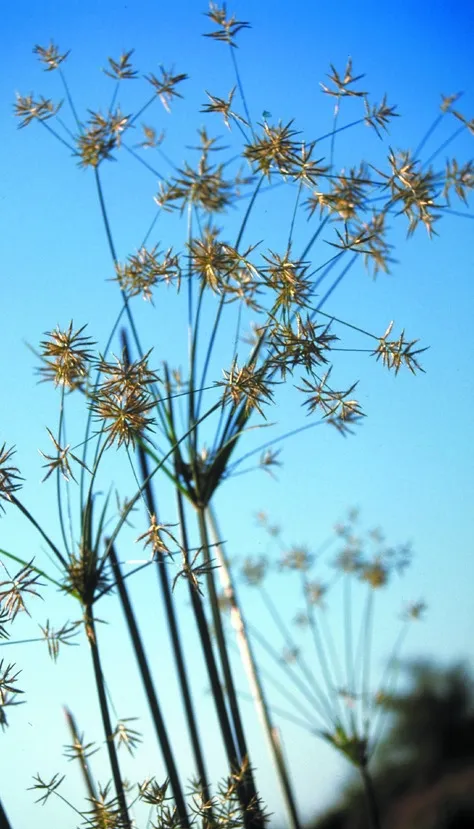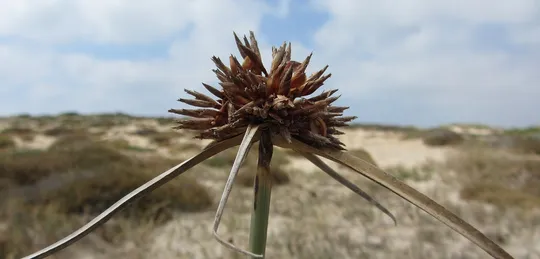Cyperus jeminicus
Cyperus jeminicus once grew at only two sites on the northern shore of the Dead Sea: En Gedi and Enot Tsukim (= En Fashha). It was collected only once from En Fashha, in 1943, and probably also grew in in En Gedi. Since the 1970s, it has not been found it in either of these locations, and is almost certainly extinct. In the additional volume of the Flora Palaestina (Danin, 2004) there is note of a herbarium specimen from the Kinarot Valley. C. jeminicus was also found in southern Sinai and it is common in the Moab canyons that run into the Dead Sea.
At the margins of springs, freshwater wetlands and hot springs. In the Moab canyons, where large populations are concentrated, the plants grow at the edge of springs flowing from the cliffs and rocks on steep slopes.
For the genus, see Cyperus corymbosus.
Cyperus jeminicus is systematically close to the C. macrorrhizus, and there were researchers who gave it the status of a variety within C. macrorrhizus (C. conglomeratus var. effusus Boiss.). The species differs from C. macrorrhizus by its longer spikelets, by the greater number of flowers on the spikelets and by the plant’s appearance – C. jeminicus is a much taller and delicate plant. Its inflorescence is not spherical and dense as in C. macrorrhizus and it has a completely different habitat – it grows at the edge of springs, unlike C. macrorrhizus that grows on sands.
• Cyperus jeminicus is extinct in Israel. The only certain site where the plant was once found is En Fashha. The typical habitat in the Dead Sea areas are springs that flow on steep slopes in desert canyons. These springs are being destroyed on the Israeli side, where they are rare, as well as on the Jordanian side, where in recent years has been rapid development of water projects and tourism.
Cyperus jeminicus should be reintroduced to the Enot Tsukim reserve, Enot Kana and the David Stream at the En Gedi Nature Reserve. The ecology and demography of the C. jeminicus populations in the canyons in Jordan should be studied (e.g. in the Zarka spring, where a large population grows). A monitoring and hydrological management program should be formulated for the populations reintroduced to Israel.
Cyperus jeminicus is found mainly in the Sudanian region, with penetrations to the Saharo-Arabic region: Egypt, Sinai, Ethiopia, Socotra, Arabia, Kuwait, Aden, Yemen, Iran and Afghanistan.
Cyperus jeminicus is a Sudanian-desert plant found in desert springs. It was once known only from En Fashha and En Gedi and became extinct from Israel, but has a large population in the canyons descending from the Moab Heights in the northern Dead Sea. The northern Dead Sea is the northernmost limit of the species and there is a great distance between these populations and the southern populations of Arabia and Egypt (a single site in eastern Sinai).
Current Occupancy Map
| 1000 squre meter pixel | 5000 squre meter pixel | 10000 squre meter pixel | |
|---|---|---|---|
| number of observations | 0 | 0 | 0 |
| in total pixels | 0 | 0 | 0 |
| Family | Cyperaceae |
| Classification | On the endangered species list |
| Ecosystem | Desert |
| Chorotype | Sudano (Sudano – Arab) |
| Conservation Site | En Gedi |
| Rarity |
1
6
6
|
|---|---|
| Vulnerability |
0
4
4
|
| Attractiveness |
0
0
4
|
| Endemism |
0
0
4
|
| Red number |
1
-1.0
10
|
| Peripherality | S |
| IUCN category | DD EW EX LC CR EN VU NT |
| Threat Definition according to the red book | Extinct |
 Based on:
Based on:





